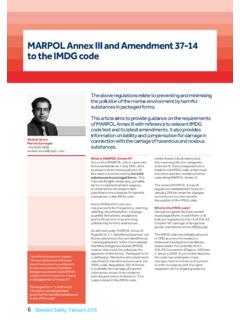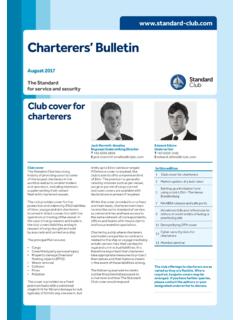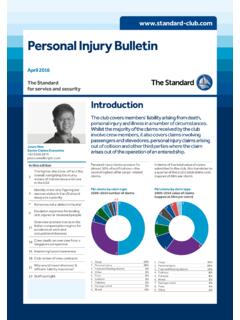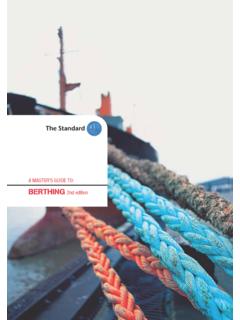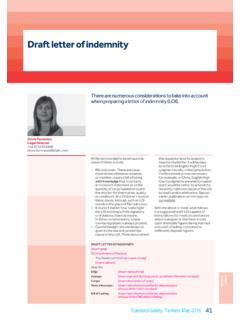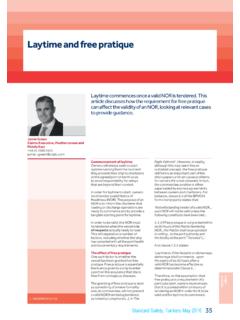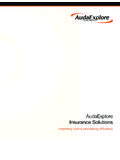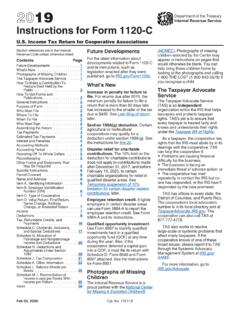Transcription of Standard Safety
1 Standard for service and securityStandard SafetyJuly 2018 The Standard for service and securityIntroduction It has been over 30 years since the Herald of Free Enterprise disaster. In that time, many of the Safety issues faced on board ships have remained constant, some have improved, and some new risks have emerged. In this edition of Standard Safety we reflect on certain pressing issues faced by members of the club, reflecting the emerging risks or demonstrating a new way to tackle an old VandenbornDirector of Loss PreventionT +65 6506 2852E capsizing of the Herald of Free Enterprise is widely recognised as the driving force behind the implementation of the ISM code in 1998. In our first article, we look at the impact the ISM code has had on the Safety of shipping and point out some shortfalls and areas where improvements could be the second article, Capt Nippin Anand provides his view on an essential ISM tool near-miss reporting.
2 He questions whether shipowners have been using this tool appropriately and argues that we should be focusing more on the quality of reporting, rather than the quantity of near-miss issue tackled by ISM is crew fatigue, which is now known to be a major contributing factor in the majority of shipping casualties. Andrew Russ explains the findings of various research projects that have been conducted around fatigue and the regulations and management systems designed to prevent it. He also touches on minimum safe manning requirements and what can be done to further reduce the risk of fatigue on IMDG code has been in existence since 1965 and has had a positive impact on Safety in that time. However, the club frequently receives queries related to the carriage of IMDG class 1 and class 7 cargoes, which suggests that work still needs to be done in this area.
3 Capt Akshat Arora sets out the club cover for these two classes of cargo and provides guidance on their systems have been common on board ships since 2009. ECDIS has improved Safety but has introduced new hazards which require consideration. Following our previous article on the use of ECDIS on board ships and the type of training which is required, Richard Bell and ChartWorld explain the problems encountered with the usage of temporary and preliminary updates, and the means to minimise these our last article in this publication, we look at the very new issue of cyber-crime. In 2017, The Standard Club worked together with Fidra Films and various industry partners to produce the award-winning Be Cyber Aware At Sea Maritime Cyber Security film. Richard Bell explains the new IMO resolution on cyber security and provides guidance for Safety landscape has developed over the last 30 years, but The Standard Club loss prevention department aims to keep step with the latest issues and provide ongoing guidance to years of the ISM code4 Near miss reporting: a (mis)leading indicator of Safety ?
4 6 The human element the effects of fatigue on ship Safety part 1 practical advice to shipowners9 Carriage of IMDG cargoes11T&Ps and ECDIS: considerations for deck officers14 Cyber security2 Twenty years of the ISM codeThe International Maritime Organization (IMO) s Guidelines on Management for the Safe Operation of Ships and for Pollution Prevention (ISM code) first became mandatory in 1998. Twenty years and five amendments later, we reflect on how the code is doing and what still needs to be ISM code was born out of a series of serious shipping accidents in the 1980s, the worst of which was the roll-on roll-off ferry Herald of Free Enterprise which capsized at Zeebrugge in March 1987, killing 193 of its 539 passengers and crew. The cause of these accidents was a combination of human error on board and management failings on shore.
5 The Herald of Free Enterprise public enquiry report concluded that From top to bottom the body corporate was infected with the disease of sloppiness .What followed was a much-needed change in maritime Safety administration. In October 1989, the International Maritime Organization (IMO) adopted new Guidelines on Management for the Safe Operation of Ships and for Pollution Prevention giving operators a framework for the proper development, implementation and assessment of Safety and pollution prevention management in accordance with good practice . Following industry feedback, the guidelines became the ISM code in November 1993 and were incorporated in a new chapter IX of the IMO s 1974 International Convention for the Safety of Life at Sea (SOLAS) in May 1994, and became mandatory for companies operating certain types of ships from 1 July the requirements of the code is evidenced by ships flag states in five-year documents of compliance for ship operators and five-year Safety management certificates for ships, both of which are subject to regular impactThe ISM code requires nearly all the world s ship operators to write and implement on-board Safety management systems (SMS) for their ships and make a designated person ashore responsible for every ship s safe operation.
6 For many shipowners and operators, ISM was simply a new legal framework for the Safety systems they already had, but for others, it led to major and much-needed changes in operating culture and organisation. It forced companies with poor or weak management systems to create a formal, structured Safety management process for the first time even if they saw it as just more red tape .Certainly, the ISM code has made shipping safer and cleaner over the past two decades. In 2005, the IMO maritime Safety committee asked for a report on the impact of the code from an international group of experts. Based on the data collected, the group concluded that where the code is embraced as a positive step toward efficiency through a Safety culture, tangible positive benefits are evident .Yves VandenbornDirector of Loss PreventionT +65 6506 2852E Standard Club has been assessing members management systems since 1993 through our member risk review programme.
7 Linked to our ship risk review programme, the review was formerly based on our minimum operating standards , but since 1998, it has focused (among other things) on how ISM requirements are being met from the perspective of a liability such, we have seen at first hand the many positive changes the ISM code has brought to the marine industry. Most of our members are now using ISM effectively to increase Safety on board their ships. This includes creating safe working practices and working environments, making suitable safeguards against potential risks and continuously improving the Safety management skills of personnel, as well as the development of emergency response plans for both Safety and environmental for improvementBut despite its success to date, we believe there is still scope for our members to improve the effectiveness of more effective SMS documentationOne issue we have noticed is the tendency for SMS documentation to be too long.
8 Making it bulky and difficult to read defeats its purpose it should be short, simple and easily understood. In addressing this concern, we have witnessed a number of our larger members carrying out major reviews of their systems to reduce the volume of text and replace it with flow charts, diagrams and other visual signs to assist quick documentation should also be unique to the ship, even if it starts life as a Standard , off-the-shelf manual. There is no point, for example, in having tanker procedures in an SMS for a dry bulk cargo ship or having pre-departure checks for bow thrusters where none key point to note in drafting SMS checklists is that they should balance the need to remind crewmembers what to do and instruct them step-by-step on how to do it. This will help make ISM more than just a paper exercise. However, the longer the checklists, the less likely they are to be followed , new procedures and checklists should not be added to an existing SMS without properly reviewing older procedures and removing or consolidating them as necessary.
9 This will ensure there is no duplication or , the SMS documentation needs to be readily accessible to both office staff and crewmembers on board. Crewmembers should know exactly where the documentation is on a ship and how they can quickly find the procedures and checklists they a sensible approach to near-miss reportingWe are aware that ISM has prompted some shipowners to encourage an over-the-top approach to reporting near misses and non-conformities in the mistaken belief this alone will improve Safety . This method has also been encouraged by major charterers in the wet and dry Capt Nippin Anand argues in the next article, there should be no minimum target set for the number of nearmiss reports. The focus should be on learning from genuine near misses and non-conformities. Creating paperwork for these incidents is of little value if the lessons learnt are not built into training programmes and new Safety reports should be analysed and categorised so they can be combined with reports from other ships in the fleet.
10 They should also be cross-referenced with similar statistics and categories from port state control (PSC) inspections, oil major inspections (SIRE) and Rightship category standing out in key performance indicators (KPIs) needs further analysis. Lessons learnt should be incorporated into the next quarterly or yearly training programme. A real incident is less likely if such steps are ISM review reportsWe also believe shipowners and operators should pay more attention to their masters SMS review 2008 update to the ISM code made masters responsible for periodically reviewing the SMS and reporting deficiencies to shore-based management . In our experience, these vital reports are very often incomplete (or say everything is satisfactory) and certainly are not dealt with should be encouraged to discuss the SMS reviews with crewmembers as they are the key users of the documentation and should have the biggest input into any proposed changes.
